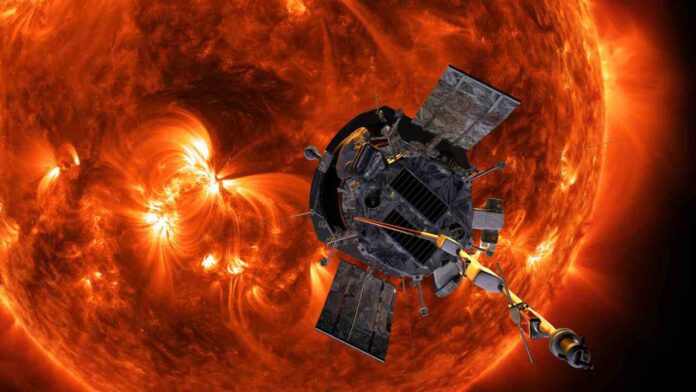NASA’s Parker Solar Probe has racked up an impressive list of superlatives in its first five years of operations: It’s the closest spacecraft to the sun, the fastest human-made object and the first mission to ever “touch the sun.”
Now, Parker has one more feather to add to its sun-kissed cap: It’s the first spacecraft ever to fly through a powerful solar explosion near the sun.
As detailed in a new study published Sept. 5 in The Astrophysical Journal—exactly one year after the event occurred—Parker Solar Probe passed through a coronal mass ejection (CME).
These fierce eruptions can expel magnetic fields and sometimes billions of tons of plasma at speeds ranging from 60 to 1,900 miles (100 to 3,000 kilometers) per second. When directed toward Earth, these ejections can bend and mold our planet’s magnetic field, generating spectacular auroral shows and, if strong enough, potentially devastate satellite electronics and electrical grids on the ground.
Cruising on the far side of the sun just 5.7 million miles (9.2 million kilometers) from the solar surface—22.9 million miles (36.8 million kilometers) closer than Mercury ever gets to the sun—Parker Solar Probe first detected the CME remotely before skirting along its flank. The spacecraft later passed into the structure, crossing the wake of its leading edge (or shock wave), and then finally exited through the other side.
A composite of images collected by Parker Solar Probe’s Wide-field Imager for Solar Probe (WISPR) instrument captures the moment the spacecraft passed through a coronal mass ejection (CME) on Sept. 5, 2022. The event becomes visible at 0:14 seconds. The sun, depicted on the left, comes closest on Sept. 6, when Parker reached its 13th perihelion. The sound in the background is magnetic field data converted into audio. Credit: NASA/Johns Hopkins APL/Naval Research Laboratory/Brendan Gallagher/Guillermo Stenborg/Emmanuel Masongsong/Lizet Casillas/Robert Alexander/David Malaspina
In all, the sun-grazing spacecraft spent nearly two days observing the CME, providing physicists an unparalleled view into these stellar events and an opportunity to study them early in their evolution.
“This is the closest to the sun we’ve ever observed a CME,” said Nour Raouafi, the Parker Solar Probe project scientist at the Johns Hopkins Applied Physics Laboratory (APL) in Laurel, Maryland, which built the spacecraft within NASA’s timeline and budget, and currently manages and operates the mission. “We’ve never seen an event of this magnitude at this distance.”
The CME on Sept. 5, 2022, was an extreme one. As Parker passed behind the shock wave, its Solar Wind Electrons, Alphas and Protons (SWEAP) instrument suite clocked particles accelerating up to 840 miles (1,350 kilometers) per second. Had it been directed toward Earth, Raouafi suspects it would have been close in magnitude to the Carrington Event—a solar storm in 1859 that is held as the most powerful on record to hit Earth.
“The potential damage of this class of event, large and very fast CMEs, can be colossal,” Raouafi said.
Physicists have surmised that such an event today, if detected too late, could disable communications systems and spawn continent-wide blackouts.
Despite the eruption’s power, Parker seemed unfazed. Its heat shield, radiators and thermal protection system ensured the Probe’s temperatures never changed, said Jim Kinnison, the Parker Solar mission systems engineer at APL. Its autonomy system even triggered mitigation plans so the avionics suite worked without interruption. In fact, the only effect the CME had on the spacecraft was a slight torque—a tiny turn for which it quickly compensated.
“We knew from the beginning that Parker Solar Probe would fly through CMEs. That was part of the science objectives when the mission was established, so we designed the spacecraft from the start with an eye to surviving and, better yet, performing the science mission while in a CME,” Kinnison said. “All in all, Parker proved itself to be robust and pretty tough, and all the hard work done in the design phase paid off.”
Physicists have been interested in deciphering the forces that drive these stellar explosions and accelerate particles to such incredible clips. The only way to do that was to fly through one at the sun.
The science team determined the timeline of events and Parker’s location during the CME by comparing measurements collected within the CME with those gathered outside it, including imagery taken by the Sun Earth Connection Coronal and Heliospheric Investigation (SECCHI) instrument on NASA’s STEREO spacecraft. They built a simple model of the event, but given that nobody has ever taken measurements this early in a CME’s development, some pieces were difficult to reconcile.
“You try simplified models to explain certain aspects of the event, but when you are this close to the sun, none of these models can explain everything,” said Orlando Romeo, a space physicist at the University of California, Berkeley, and the lead author of the new study.
The team had determined three major intervals during the event, but piecing them together, Romeo said, was particularly confusing. Two sections they had seen before in CMEs when they arrived at Earth: the shock wave near the event’s front followed by CME plasma, and another portion with magnetic and plasma characteristics typical of the sun’s solar wind. But the third section—a low-density-region with slow-moving particles during the event—was new and odd.
“We’re still not exactly sure what is happening there or how to connect it to the other two sections,” Romeo said.
Advanced models that include more of the spacecraft’s measurements will likely help, but passing through another CME would do even better. With the sun near the peak of its activity cycle, CMEs should happen more frequently. With a bit of luck, the team hopes, Parker Solar Probe will fly through several more ejections as it winds ever closer to the sun.
Reference:
O. M. Romeo et al, Near-Sun In Situ and Remote-sensing Observations of a Coronal Mass Ejection and its Effect on the Heliospheric Current Sheet, The Astrophysical Journal (2023). DOI: 10.3847/1538-4357/ace62e
